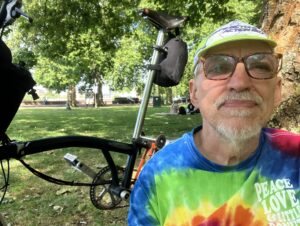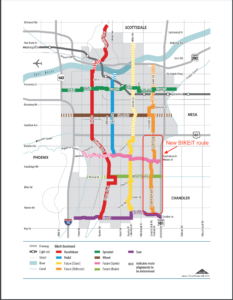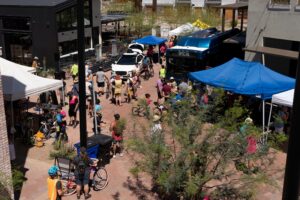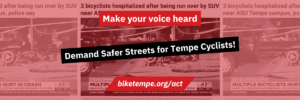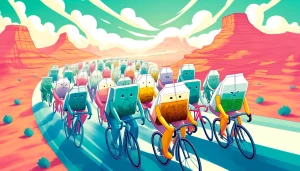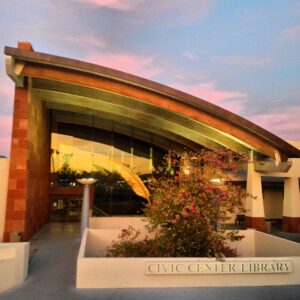Phoenix Bikeability (MIT article)

There’s something freeing about riding a bicycle as a child. The world feels like it’s yours; you think you can go anywhere with little more than two wheels and a handlebar. As we grow, that wonder should remain, rather than fade. We need to question why many lose the desire to ride a bicycle to school or the grocery store as adults. We need to assess the reality that other cities are far more bikeable than Phoenix, and we are bystanders in allowing our city to be left behind if we don’t act. We each need to seriously consider bicycling when thinking of how to get around and acknowledge that we all have a role in facilitating the necessary change in the Valley.
In Phoenix, there are many misconceptions around bicycling as a primary form of transportation. The problems with this mentality are clear when considering the impacts of climate change on Phoenix, with future predictions expecting longer heat waves and more severe droughts, which are only exacerbated by increased single-occupancy vehicle use. As this summer is already giving us a glimpse of what the future holds with record heat and droughts, it is imperative that we change our relationship with cycling for the health of our community and planet.
The benefits of bicycling are not only for environmentalists. Phoenix currently has some of the most congested roads in the country, so more cyclists on the road means quicker commute times for cyclists and motorists alike. Bicycling is inexpensive and versatile, in addition to being an excellent form of exercise. It is also a socially-distant mode of transport, which is especially necessary in light of COVID-19. All that’s needed is greater awareness and more equitable infrastructure.
We must support initiatives to improve bike infrastructure in our neighborhoods. The City of Phoenix is in the process of implementing a bicycling plan. As a complement to the original plan, the Shifting Gears plan details more specific proposed infrastructure improvements from North Phoenix down to South Mountain. However, progress towards the goals in the bicycling plan has been slow, largely in part to conflicting city council priorities. We need to realize that it is by active design that our roads appear to be made only for cars, and it is the culmination of conscious choices of our city’s leadership that have resulted in many of our roads remaining incompatible with those who use (or want to use) bicycling as a primary mode of transportation.
But we do not need to wait for these infrastructure improvements to begin bicycling: there is already a decent amount of bicycling infrastructure within the city that is underutilized. The Maricopa Association of Governments Active Transportation recently created a great map depicting all of the bike routes throughout the Valley. Currently, Phoenix has received a bronze rating from the League of American Bicyclists, which acknowledges these initial steps and provides clear recommendations for improvements.
There are several bike advocacy groups looking for more support and are a great way to find more recommendations about biking routes. These groups include the Tempe Bike Action Group, Phoenix Spokes People, and the Coalition of Arizona Bicyclists. Each works to promote bicycling infrastructure and acceptance by working with local government, businesses, and residents to publicize and popularize the benefits of bicycling. They provide a welcoming community for new and established bicyclists alike.
However, more work needs to be done. Bicyclists are far more likely to take to the streets if they feel safe. With 220 pedestrian fatalities in 2019, there is a lot of room for improvement of the safety of Arizona’s roads. People who drive cars, trucks, and SUVs need to embrace sharing the roads with bikes, slowing down, and giving cyclists space. We expect our roads to be safe for everyone but we routinely exceed the speed limit and fail to yield to pedestrians riding bicycles or walking.
Furthermore, the City of Phoenix continues to develop as if driving a gasoline vehicle is the only way to get around. What about light rail, bus, walking, and riding bicycles? Developers are rarely required to install bike racks or provide connectivity to the corner grocery store. Developers are not required to provide safe paths to elementary or junior high schools. Phoenix has the ability to change its patterns of development, but it won’t happen on its own.
As residents, we have a responsibility to voice our opinions to our local governments, including the mayor, the city manager, and the city council. Promoting bicycling with local businesses, during community events, and on social media will help to show that these projects are valued and desired by us. The only way to avoid municipal finance burdens in large cities is to design for density, which can be accomplished by considering all modes of transport. On November 3, 2020, we will be electing the mayor and council districts 1, 3, 5, and 7. Consider voting for candidates who will prioritize all users of the road—drivers, cyclists, and pedestrians. Consider candidates like Yassamin Ansari for Council District 7, or Nate Schick for District 5. Vote for city council members who value safety and are excited to make Phoenix more bikeable. Let’s make a city where both eight-year-olds and eighty-year-olds can navigate safely.
Phoenix might not be where it needs to be yet, but it won’t get there unless we, its residents, express our opinions and make it a priority to those who are in office. One vocal resident can make a tremendous amount of difference. Whether you bike frequently, are a casual rider, or hop in your car to get around, we all have a role to play to make Phoenix a safer, more accessible, and environmentally friendly city.
Written by Tessa Weiss, a Phoenix native, along with Zachariah DeGiulio and Danielle Grey-Stewart, all members of the MIT Rapid Response Group. A special thanks to Joseph Perez, Jeff Caslake, Bob Beane, and Bill McComas for their insights.
<editor’s note> This article is reprinted as-is, without modification, and with permission of the original authors. The Tempe Bicycle Action Group does NOT endorse any political candidate or party.

